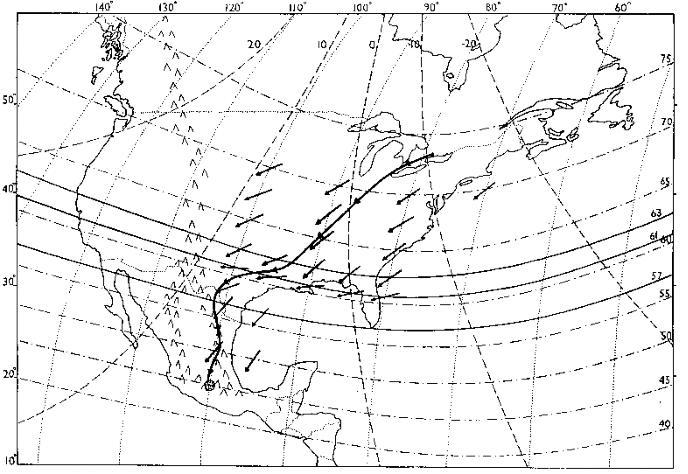Compass Bearings Hypothesis
Suns' Azimuth Hypothesis
Expansion-Contraction Hypothesis
Never Go Back Hypothesis
A Theoretical Kiepenheuer,
Schmidt-Koenig, and Gibo, Magnetoclinic, Magnetic Latitude, Late Summer and Fall Migration
Route for Eastern Population of Monarch Butterflies
Mississauga, Ontario, Canada, in Lower Great Lakes region used as Starting Point

Drawing by Diane Scott
Labels
- Joined arrows indicate one possible K/S-K/G Magnetoclinic, Magnetic Latitude late summer and fall migration route from lower Great Lakes region (i.e. Mississauga, Ontario).
- Arrows centred on lines of longitude and on or north of the 63° isocline of magnetic inclination indicate direction of local K/S-K Magnetoclinic routes.
- Arrows south of the 55° isocline of magnetic inclination located along the Sierra Madre Oriental and in the Gulf also indicate local K/S-K magnetoclinic routes.
- Arrows centred on the 61° isocline and the single arrow centred at 30° latitude, 100° longitude indicates local K/S-K/G Magnetoclinic, Magnetic Latitude routes.
- All other lines, graphics and numbers along margins, are the same as in drawing of the Kiepenheuer and Schmidt-Koenig Magnetoclinic late summer and fall route.
Notes
- Drawing shows earlier version of model with band of clockwise rotation extending between 63° and 57° isoclines and maximum rotation at 61°. Model discussed in text assumes band extends from 65° to 55° isoclines, with peak clockwise rotation at 60°.
- The location where Brower (1985) indicated that the migrants turn inland, approximately latitude 23° and longitude 95°, is also their first opportunity, after detouring around the Gulf and turning SSE to fly along the east slopes of the Sierra Madre Oriental, for the butterflies to rejoin the K/S-K Magnetoclinic route that originates in the lower Great Lakes region.